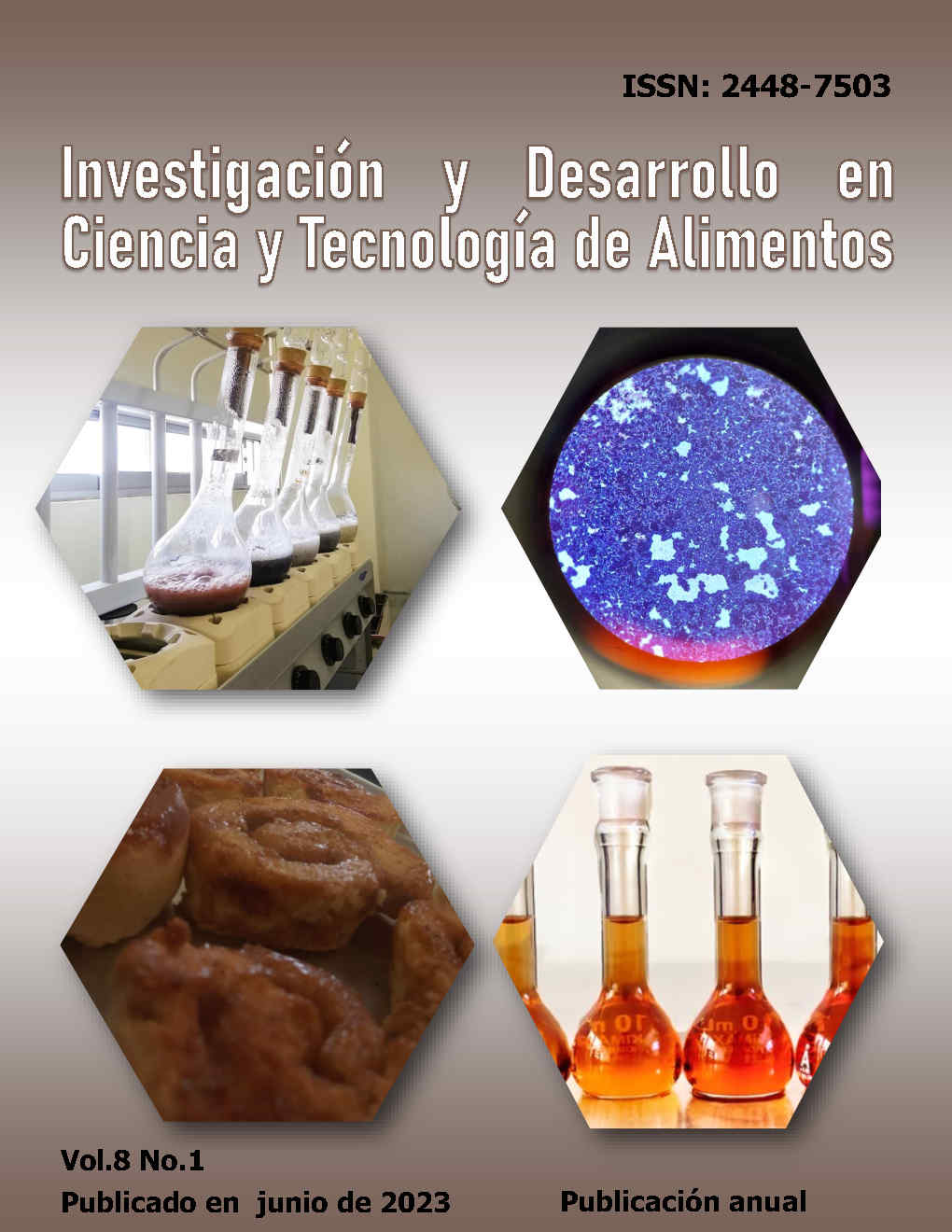Obtención de fermentados de chía con actividad antihipertensiva
DOI:
https://doi.org/10.29105/idcyta.v8i1.79Keywords:
Antihipertensivo, ECA, Lactococcus, Salvia hispánica, ChíaAbstract
The presence of bioactive compounds in food has taken relevance, since it has been seen that they contain antioxidant, antihistamine, anticancer, antihypertensive, etc., properties that we can take advantage to improve health. However, it is necessary to extract them from the original source. In this work we are going to show how a fermentation of chia flour with bacteria of the Lactococcus gender helps to release compounds with antihypertensive activity. Because they could inhibit the activity of the angiotensin converting enzyme (ACE) (one of the enzymes responsible for raising up the blood pressure).
Downloads
References
Aguirre, L., Hebert, E. M., Garro, M. S., & Savoy de Giori, G. (2014). Proteolytic activity of Lactobacillus strains on soybean proteins. LWT - Food Science and Technology, 59(2P1), 780–785. https://doi.org/10.1016/j.lwt.2014.06.061 DOI: https://doi.org/10.1016/j.lwt.2014.06.061
Ayerza, R., Coates, W., & Lauria, M. (2002). Chia seed (Salvia hispanica L.) as an ω-3 fatty acid source for broilers: Influence on fatty acid composition, cholesterol and fat content of white and dark meats, growth performance, and sensory characteristics. Poultry Science, 81(6), 826–837. https://doi.org/10.1093/ps/81.6.826 DOI: https://doi.org/10.1093/ps/81.6.826
Baba, W. N., Baby, B., Mudgil, P., Gan, C. Y., Vijayan, R., & Maqsood, S. (2021). Pepsin generated camel whey protein hydrolysates with potential antihypertensive properties: Identification and molecular docking of antihypertensive peptides. Lwt, 143(February), 111135. https://doi.org/10.1016/j.lwt.2021.111135 DOI: https://doi.org/10.1016/j.lwt.2021.111135
Bradstreet, R. B. (1940). A review of the kjeldahl determination of organic nitrogen. Chemical Reviews, 27(2), 331–350. https://doi.org/10.1021/cr60087a002 DOI: https://doi.org/10.1021/cr60087a002
Cortés-Ríos, J., Zárate, A. M., Figueroa, J. D., Medina, J., Fuentes-Lemus, E., Rodríguez-Fernández, M., Aliaga, M., & López-Alarcón, C. (2020). Protein quantification by bicinchoninic acid (BCA) assay follows complex kinetics and can be performed at short incubation times. Analytical Biochemistry, 608(July). https://doi.org/10.1016/j.ab.2020.113904 DOI: https://doi.org/10.1016/j.ab.2020.113904
Cushman, D. W., & Cheung, H. S. (1971). Spectrophotometric assay and properties of the angiotensin-converting enzyme of rabbit lung. Biochemical Pharmacology, 20(7), 1637–1648. https://doi.org/10.1016/0006-2952(71)90292-9 DOI: https://doi.org/10.1016/0006-2952(71)90292-9
Ding, Y., Lin, H. W., Lin, Y. L., Yang, D. J., Yu, Y. S., Chen, J. W., Wang, S. Y., & Chen, Y. C. (2018). Nutritional composition in the chia seed and its processing properties on restructured ham-like products. Journal of Food and Drug Analysis, 26(1), 124–134. https://doi.org/10.1016/j.jfda.2016.12.012 DOI: https://doi.org/10.1016/j.jfda.2016.12.012
El Khoury, D., Vien, S., Sanchez-Hernandez, D., Kung, B., Wright, A., Goff, H. D., & Anderson, G. H. (2019). Increased milk protein content and whey-to-casein ratio in milk served with breakfast cereal reduce postprandial glycemia in healthy adults: An examination of mechanisms of action. Journal of Dairy Science, 102(8), 6766–6780. https://doi.org/10.3168/jds.2019-16358 DOI: https://doi.org/10.3168/jds.2019-16358
Enes, B. N., Moreira, L. de P. D., Toledo, R. C. L., Moraes, É. A., Moreira, M. E. de C., Hermsdorff, H. H. M., Noratto, G., Mertens-Talcott, S. U., Talcott, S., & Martino, H. S. D. (2020). Effect of different fractions of chia (Salvia hispanica L.) on glucose metabolism, in vivo and in vitro. Journal of Functional Foods, 71(December 2019). https://doi.org/10.1016/j.jff.2020.104026 DOI: https://doi.org/10.1016/j.jff.2020.104026
Fitzpatrick, J. J., & Bremenkamp, I. (2019). Investigation of the effect of time on the humidity caking of food powder binary mixes using a cake strength tester and visual techniques. Journal of Food Engineering, 263(June), 195–203. https://doi.org/10.1016/j.jfoodeng.2019.06.021 DOI: https://doi.org/10.1016/j.jfoodeng.2019.06.021
Lee, S. C., Prosky, L., & Vries, J. W. De. (1992). Determination of Total, Soluble, and Insoluble Dietary Fiber in Foods—Enzymatic-Gravimetric Method, MES-TRIS Buffer: Collaborative Study. Journal of AOAC INTERNATIONAL, 75(3), 395–416. https://doi.org/10.1093/jaoac/75.3.395 DOI: https://doi.org/10.1093/jaoac/75.3.395
Leng, L., Bogush, A. A., Roy, A., & Stegemann, J. A. (2019). Characterisation of ashes from waste biomass power plants and phosphorus recovery. Science of the Total Environment, 690, 573–583. https://doi.org/10.1016/j.scitotenv.2019.06.312 DOI: https://doi.org/10.1016/j.scitotenv.2019.06.312
Raveschot, C., Cudennec, B., Deracinois, B., Frémont, M., Vaeremans, M., Dugersuren, J., Demberel, S., Drider, D., Dhulster, P., Coutte, F., & Flahaut, C. (2020). Proteolytic activity of Lactobacillus strains isolated from Mongolian traditional dairy products: A multiparametric analysis. Food Chemistry, 304(April 2019), 125415. https://doi.org/10.1016/j.foodchem.2019.125415 DOI: https://doi.org/10.1016/j.foodchem.2019.125415
Schmid, M., Guihéneuf, F., & Stengel, D. B. (2016). Evaluation of food grade solvents for lipid extraction and impact of storage temperature on fatty acid composition of edible seaweeds Laminaria digitata (Phaeophyceae) and Palmaria palmata (Rhodophyta). Food Chemistry, 208, 161–168. https://doi.org/10.1016/j.foodchem.2016.03.123 DOI: https://doi.org/10.1016/j.foodchem.2016.03.123
Segura-campos, M. R., Chel-guerrero, L. A., Rosado-rubio, J. G., & Betancur-ancona, D. A. (2016). Functional Properties of Traditional Foods. Functional Properties of Traditional Foods, 199–206. https://doi.org/10.1007/978-1-4899-7662-8 DOI: https://doi.org/10.1007/978-1-4899-7662-8_14
Downloads
Published
How to Cite
Issue
Section
License
Copyright (c) 2023 H. Atonal-Sánchez, S. Luna-Suárez

This work is licensed under a Creative Commons Attribution 4.0 International License.
Los autores/as que publiquen en esta revista aceptan las siguientes condiciones:
a. Los autores/as conservarán sus derechos de autor y garantizarán a la revista el derecho de primera publicación de su obra, el cual estará simultáneamente sujeto a la Licencia Creative Commons Atribución 4.0 Internacional. que permite a terceros compartir la obra siempre que se indique su autor y su primera publicación esta revista.
b. Los autores/as pueden realizar otros acuerdos contractuales independientes y adicionales para la distribución no exclusiva de la versión del artículo publicado en esta revista (p. ej., incluirlo en un repositorio institucional o publicarlo en un libro) siempre que indiquen claramente que el trabajo se publicó por primera vez en esta revista.
c. Se permite y recomienda a los autores/as a publicar su trabajo en Internet (por ejemplo en páginas institucionales o personales) posterior al proceso de revisión y publicación, ya que puede conducir a intercambios productivos y a una mayor y más rápida difusión del trabajo publicado.





